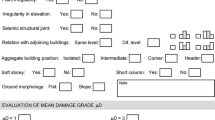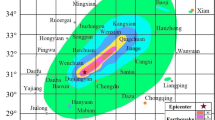Abstract
Few empirical seismic vulnerability curves exist for non-engineered reinforced concrete buildings in developing countries, and this is particularly true for the South Asian countries. This category of buildings is widespread and is highly vulnerable, since the buildings suffer from serious problems due to poor design and construction and are prone to collapse in moderate earthquakes. In this paper, building damage data from the Kashmir earthquake (2005), Pakistan are utilized to develop empirical vulnerability curves for the non-engineered reinforced concrete structures in the region. In order to develop empirical vulnerability curves, a damage probability matrix was defined and its elements corresponding to damage ratio of different damage states are used to evaluate the mean damage ratio. The developed curve show abrupt damage accumulation at relatively small values of peak ground acceleration. The findings of mean damage ratio as a function of peak ground acceleration are compared with the most relevant existing empirical and judgmental vulnerability curves to show the severity of damage in non-engineered reinforced concrete structures of that region and to validate for use in risk assessment studies.















Similar content being viewed by others
References
ADB-WB (2005) Preliminary damage and needs assessment—Pakistan 2005 earthquake, prepared by Asian Development Bank and World Bank, Islamabad, Pakistan, November 12, 2005
Ahmad N (2008) Development of a seismic risk/loss model for Mansehra City, Pakistan. Masters Thesis, Universit_A Degli Studi Di Pavia
Ahmad S (2011) Seismic vulnerability of non-ductile reinforced concrete structures in developing countries. The University of Sheffield, UK, Department of Civil and Structural Engineering, Ph.D Thesis
Ambraseys NN, Douglas J, Sarma SK, Smit PM (2005) Equations for the estimation of strong ground motions from shallow crustal earthquakes using data from Europe and the middle east: horizontal peak ground acceleration and spectral acceleration. Bull Earthq Eng 3:1–53
ATC-20 (1989) Procedures for post earthquake safety evaluation of buildings. Publication of Applied Technology Council, Redwood City
Braga F, Dolce M, Liberatore D (1982) A statistical study on damaged buildings and ensuing review of the MSK-76 scale. In: Proceedings of 7th European conference on earthquake engineering, Athens
DiPasquale G, Orsini G, Romeo RW (2005) New developments in seismic risk assessment in Italy. Bull Earthq Eng 3(1):101–128
Dolce M, Masi A, Marino M, Vona M (2003) Earthquake damage scenarios of the building stock or Potenza (Southern Italy) including site effects. Bull Earthq Eng 1(1):115–140
Duranni AJ, Elnashai AS, Hashash YMA, Kim SJ, Masud A (2005) The Kashmir earthquake of October 8, 2005, a quick look report. Mid-America Earthquake Center. University of Illinois at Urbana-Champaign
ERRA-PERRA (2007) Earthquake reconstruction and rehabilitation authority. Government of Pakistan-Provisional Reconstruction and Rehabilitation Agency, Government of Khyber Pakhtunkhwa (KPK)
FEMA154 (2002) Rapid visual screening of buildings for potential seismic hazards: a handbook, 2nd edn. Earthquake hazard reduction series 41
FBS (2010) “Monthly review on price indices” federal bureau of statistics, ministry of economic affairs and statistics. Government of Pakistan
GESI (2001) Global earthquake safety initiative (GESI). Pilot project, GeoHazards International (GHI). UNCRD
Grünthal G, Musson RMW, Schwarz J, Stucchi M (1998) European macroseismic scale 1998. Centre Europeén de Géodynamique et deSéismologie 15, Luxembourg
GSP (2006) Geological map of Mansehra quadrangle, District Mansehra, NWFP. Geological Survey of Pakistan, Peshawar
HAZUS (1999) Earthquake loss estimation methodology, technical manual. Report prepared for the Federal Emergency Management Agency, Washington, DC, under a contract with NIBS
JICA (2006) Detailed building damage distribution map (right bank of Neelum river)
JICA (2007) The urgent development study on rehabilitation and reconstruction in Muzaffarabad city in the Islamic Republic of Pakistan. Final report 1: Volume 2: Main report
Khan S (2010) An earthquake risk assessment framework for developing countries: Pakistan a case study. Phd Thesis, The University of Sheffield
Kim SJ, Elnashai AS (2009) Characterization of shaking intensity distribution and seismic assessment of RC buildings for the Kashmir (Pakistan) earthquake of October 2005. Eng Struct 31:2998–3015
Kyriakides N (2008) Seismic vulnerability assessment of RC buildings and risk assessment for cyprus. Phd Thesis, The University Of Sheffield
Kyriakides N, Ahmad S, Pilakoutas K, Neocleous K, Chrysostomou C (2014) A probabilistic analytical seismic vulnerability assessment framework for substandard structures in developing countries. Earthq Struct 6(6):665–687
Miyakoshi J, Hayashi Y, Tamura K, Fukuwa N (1997) Damage ratio functions of buildings using damage data of the 1995 Hyogoken–Nanbu earthquake. In: Paper presented at the ICOSSAR 1997, Kyoto, Japan
MonaLisa (2008) Seismic hazard assessment of Mansehra. Department of Earth Sciences, Quaid-e-Azam University (QAU), Islamabad
Naseer A, Ali SM, Hussain Z (2006) Reconnaissance report on the 8th October, 2005 earthquake Pakistan. Earthquake Engineering Centre, Department of Civil Engineering NWFP UET Peshawar, Pakistan
National Disaster Management Authority (NDMA). Government of Pakistan
Nisikawa T, Nakano Y, Tsuchiya Y, Sanada Y, Sameshima H (2005) Quick report of damage investigation on buildings and houses due to October 8, 2005 Pakistan earthquake. Japan Society of Civil Engineers (JSCE) and Architectural Institute of Japan (AIJ)
Orsini G (1999) A model for buildings vulnerability assessment using the parameterless scale of seismic intensity (PSI). Earthq Spectra 15:463–483
Peiris N, Rossetto T, Burton P, Mahmood S (2005) EEFIT Mission: October 8, 2005 Kashmir earthquake. The Institution of Structural Engineers, London
Rossetto T, Elnashai AS (2003) Derivation of vulnerability functions for European-type RC structures based on observational data. Eng Struct 25:1241–1263
Rota M, Penna A, Strobbia C (2006) Typological fragility curves from Italian earthquake damage data. In: Proceedings 1st European conference on earthquake engineering and seismology, Geneva
Schnabel WE (1987) The accumulation of potential in Cyprus. In: number 13: earthquake risk and insurance—e.g. in Cyprus. Nicosia, Cyprus, pp 87–130
SSP (2006) Azad Jammu and Kashmir soils and landforms: map prepared at soil survey of Pakistan regional office. Peshawar
Stegemeier RJ (2008) Mitigating seismic risk in developing countries: a case study on the 2005 Kashmir earthquake. Rice University, Houston
Theodulidis NP, Papazachos BC (1992) Dependence of strong ground motion on magnitude-distance, site geology and macroseismic intensity for shallow earthquakes in Greece: I, peak horizontal acceleration, velocity and displacement. J Soil Dyn Earthq Eng 11:387–402
UNDP-ERRP (2008) United Nation Development Programme (UNDP), Pakistan-earthquake risk reduction and preparedness (ERRP) project. Muzzaffarabad city’s Earthquake Scenario
Wells DL, Coppersmith KJ (1994) New empirical relationships among magnitude, rupture length, rupture width, rupture area, and surface displacement. Bull Seismol Soc Am 84:974–1002
Whitman R, Reed J, Hong S (1973) Earthquake damage probability matrices. In: Paper presented at the proceedings of the fifth world conference on earthquake engineering, Rome
Acknowledgments
The first author acknowledges the financial support provided by Higher Education Commission (HEC), Pakistan to conduct this research as a part of development of analytical seismic vulnerability assessment framework for reinforced concrete structures of developing countries. Moreover, the first author also acknowledges the UNDP (Pakistan) for providing the Kashmir earthquake damage data and building inventory.
Author information
Authors and Affiliations
Corresponding author
Rights and permissions
About this article
Cite this article
Ahmad, S., Khan, S.A., Pilakoutas, K. et al. Empirical vulnerability assessment of the non-engineered reinforced concrete structures using the Kashmir earthquake damage data. Bull Earthquake Eng 13, 2611–2628 (2015). https://doi.org/10.1007/s10518-015-9735-0
Received:
Accepted:
Published:
Issue Date:
DOI: https://doi.org/10.1007/s10518-015-9735-0




